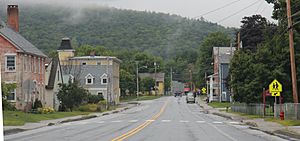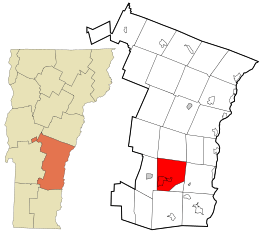Cavendish, Vermont facts for kids
Quick facts for kids
Cavendish, Vermont
|
|
|---|---|

Downtown on a foggy day
|
|

Location in Windsor County and the state of Vermont.
|
|
| Country | United States |
| State | Vermont |
| County | Windsor |
| Communities |
|
| Area | |
| • Total | 39.7 sq mi (102.8 km2) |
| • Land | 39.5 sq mi (102.2 km2) |
| • Water | 0.2 sq mi (0.6 km2) |
| Elevation | 1,017 ft (310 m) |
| Population
(2020)
|
|
| • Total | 1,392 |
| • Density | 35.071/sq mi (13.541/km2) |
| Time zone | UTC-5 (Eastern (EST)) |
| • Summer (DST) | UTC-4 (EDT) |
| ZIP Codes |
05142 (Cavendish)
05153 (Proctorsville) |
| Area code(s) | 802 |
| FIPS code | 50-12250 |
| GNIS feature ID | 1462066 |
Cavendish is a small town in Vermont, United States. It is located in Windsor County. The town was likely named after William Cavendish, 4th Duke of Devonshire, a famous English duke. In 2020, about 1,392 people lived here. Cavendish includes two main villages: Cavendish and Proctorsville.
Contents
A Look Back: History of Cavendish
Who Settled Cavendish?
The first permanent settler in Cavendish was Captain John Coffeen. He arrived with his family in June 1769. They built their home in the northern part of town. The Coffeens were the only family in Cavendish for two years.
In the early 1780s, Leonard Proctor and Salmon Dutton moved from Massachusetts. They gave their names to the two main villages along the Black River. These villages are Proctorsville and Duttonsville.
Town Beginnings
The first recorded town meeting happened in 1782. Salmon Dutton was elected as the town clerk. He helped create the first road from Duttonsville to Ludlow in 1784. This road is now part of Vermont routes 103 and 131.
In 1786, Dutton became the town's first justice of the peace. He also led town meetings and served as treasurer. Later, in 1858, Redfield Proctor married Emily Dutton. This marriage brought together the leading families of the two villages.
Exploring Cavendish: Geography and Climate
Where is Cavendish Located?
Cavendish covers about 102.8 square kilometers (39.7 square miles). Most of this area, 102.2 square kilometers (39.5 square miles), is land. Only a small part, 0.6 square kilometers (0.23 square miles), is water.
In 2011, Hurricane Irene caused major flooding in Vermont. Cavendish was one of thirteen towns that became isolated because of the floods.
What is the Weather Like?
Cavendish has a humid continental climate. This means it has big changes in temperature throughout the year. Summers are warm to hot and often humid. Winters are cold, sometimes very cold.
| Climate data for Cavendish, Vermont, 1991–2020 normals, 1903-2020 extremes: 842ft (257m) | |||||||||||||
|---|---|---|---|---|---|---|---|---|---|---|---|---|---|
| Month | Jan | Feb | Mar | Apr | May | Jun | Jul | Aug | Sep | Oct | Nov | Dec | Year |
| Record high °F (°C) | 65 (18) |
63 (17) |
82 (28) |
93 (34) |
96 (36) |
100 (38) |
102 (39) |
99 (37) |
97 (36) |
89 (32) |
78 (26) |
71 (22) |
102 (39) |
| Mean maximum °F (°C) | 47 (8) |
49 (9) |
61 (16) |
77 (25) |
86 (30) |
91 (33) |
92 (33) |
90 (32) |
86 (30) |
77 (25) |
64 (18) |
50 (10) |
93 (34) |
| Mean daily maximum °F (°C) | 29.8 (−1.2) |
33.3 (0.7) |
41.6 (5.3) |
55.1 (12.8) |
68.4 (20.2) |
77.1 (25.1) |
82.1 (27.8) |
80.5 (26.9) |
72.9 (22.7) |
59.3 (15.2) |
46.4 (8.0) |
35.1 (1.7) |
56.8 (13.8) |
| Daily mean °F (°C) | 18.7 (−7.4) |
20.7 (−6.3) |
29.3 (−1.5) |
42.2 (5.7) |
54.9 (12.7) |
64.1 (17.8) |
69.0 (20.6) |
67.1 (19.5) |
59.3 (15.2) |
46.8 (8.2) |
35.9 (2.2) |
25.5 (−3.6) |
44.5 (6.9) |
| Mean daily minimum °F (°C) | 7.6 (−13.6) |
8.0 (−13.3) |
17.1 (−8.3) |
29.3 (−1.5) |
41.3 (5.2) |
51.0 (10.6) |
55.9 (13.3) |
53.7 (12.1) |
45.7 (7.6) |
34.3 (1.3) |
25.4 (−3.7) |
15.8 (−9.0) |
32.1 (0.1) |
| Mean minimum °F (°C) | −18 (−28) |
−18 (−28) |
−6 (−21) |
15 (−9) |
26 (−3) |
34 (1) |
41 (5) |
38 (3) |
28 (−2) |
19 (−7) |
7 (−14) |
−10 (−23) |
−23 (−31) |
| Record low °F (°C) | −38 (−39) |
−40 (−40) |
−27 (−33) |
−2 (−19) |
17 (−8) |
20 (−7) |
33 (1) |
28 (−2) |
17 (−8) |
9 (−13) |
−17 (−27) |
−42 (−41) |
−42 (−41) |
| Average precipitation inches (mm) | 3.76 (96) |
2.73 (69) |
3.50 (89) |
3.75 (95) |
3.89 (99) |
4.57 (116) |
4.04 (103) |
3.94 (100) |
3.82 (97) |
4.86 (123) |
3.63 (92) |
4.05 (103) |
46.54 (1,182) |
| Average snowfall inches (cm) | 21.20 (53.8) |
18.70 (47.5) |
17.10 (43.4) |
4.10 (10.4) |
0.10 (0.25) |
0.00 (0.00) |
0.00 (0.00) |
0.00 (0.00) |
0.00 (0.00) |
0.80 (2.0) |
4.50 (11.4) |
16.80 (42.7) |
83.3 (211.45) |
| Source 1: NOAA | |||||||||||||
| Source 2: XMACIS (records & monthly max/mins) | |||||||||||||
People of Cavendish: Demographics
| Historical population | |||
|---|---|---|---|
| Census | Pop. | %± | |
| 1790 | 491 | — | |
| 1800 | 922 | 87.8% | |
| 1810 | 1,295 | 40.5% | |
| 1820 | 1,551 | 19.8% | |
| 1830 | 1,498 | −3.4% | |
| 1840 | 1,427 | −4.7% | |
| 1850 | 1,576 | 10.4% | |
| 1860 | 1,539 | −2.3% | |
| 1870 | 1,823 | 18.5% | |
| 1880 | 1,276 | −30.0% | |
| 1890 | 1,172 | −8.2% | |
| 1900 | 1,352 | 15.4% | |
| 1910 | 1,208 | −10.7% | |
| 1920 | 1,319 | 9.2% | |
| 1930 | 1,418 | 7.5% | |
| 1940 | 1,398 | −1.4% | |
| 1950 | 1,374 | −1.7% | |
| 1960 | 1,223 | −11.0% | |
| 1970 | 1,264 | 3.4% | |
| 1980 | 1,355 | 7.2% | |
| 1990 | 1,323 | −2.4% | |
| 2000 | 1,470 | 11.1% | |
| 2010 | 1,367 | −7.0% | |
| 2020 | 1,392 | 1.8% | |
| U.S. Decennial Census | |||
In 2000, there were 1,470 people living in Cavendish. These people made up 617 households and 420 families. The town had about 37 people per square mile.
Most of the people living in Cavendish (97.82%) were White. A small number of people were of other races. About 0.95% of the population was Hispanic or Latino.
About 25.8% of households had children under 18 living with them. Most households (57.5%) were married couples. The average household had 2.37 people.
The median age in Cavendish was 42 years old. About 20.7% of the population was under 18. About 17.9% of people were 65 or older.
Famous People from Cavendish
- Lizzie Aiken (1817–1906), a nurse during the American Civil War, known as “Aunt Lizzie”
- Harriett Ellen Grannis Arey (1819–1901), an educator, author, and editor
- Henry B. Atherton, a soldier and lawyer who served in New Hampshire's state government
- Richard Fletcher, a member of the U.S. House of Representatives
- Ryland Fletcher, who served as the 24th Governor of Vermont
- Phineas Gage, who survived a famous accident in 1848 where an iron rod went through his head
- John Martyn Harlow, the doctor who cared for Phineas Gage after his accident
- Redfield Proctor, a United States senator, Secretary of War, and the 37th governor of Vermont
- William H. Proctor, a Wisconsin State Assemblyman and farmer
- Colonel Thomas O. Seaver, a Civil War hero who received the Medal of Honor
- Aleksandr Solzhenitsyn, a famous Russian writer and historian who won the Nobel Prize
- Nettie Maria Stevens, an American geneticist who studied genes
Images for kids
See also
 In Spanish: Cavendish (Vermont) para niños
In Spanish: Cavendish (Vermont) para niños




